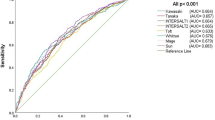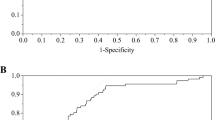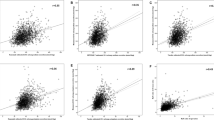Abstract
Background/objectives
To test the diagnostic ability of two combined practical markers for elevated urine osmolality (underhydration) in free-living adults and children.
Subjects/methods
One hundred and one healthy adults (females n = 52, 40 ± 14 y, 1.70 ± 0.95 m, 76.7 ± 17.4 kg, 26.5 ± 5.5 kg/m2) and 210 children (females = 105, 1.49 ± 0.13 m, 43.4 ± 12.6 kg, 19.2 ± 3.2 kg m−2) collected urine for 24-h. Urine was analyzed for urine osmolality (UOsm), color (UC), while the number of voids (void) was also recorded. Receiver Operating Characteristic (ROC) analysis was performed for UC, void, and combination of UC and void, to determine markers’ diagnostic ability for detecting underhydration based on elevated UOsm (UOsm ≥ 800 mmol kg−1).
Results
Linear regression analysis revealed that UC was significantly associated with UOsm in both adults (R2 = 0.38; P < 0.001) and children (R2 = 0.45; P < 0.001). Void was significantly associated with UOsm in both adults (R2 = 0.13; P < 0.001) and children (R2 = 0.15; P < 0.001). In adults, when UC > 3 and void <7 were combined, the overall diagnostic ability for underhydration was 97% with sensitivity and specificity of 100% and 88%, respectively. In children, UC > 3 and void <5 had an overall diagnostic ability for underhydration of 89% with sensitivity and specificity of 100% and 62%, respectively.
Conclusions
Urine color alone and the combination of urine color with void number can a valid and simple field-measure to detect underhydration based on elevated urine osmolality.
This is a preview of subscription content, access via your institution
Access options
Subscribe to this journal
Receive 12 print issues and online access
$259.00 per year
only $21.58 per issue
Buy this article
- Purchase on Springer Link
- Instant access to full article PDF
Prices may be subject to local taxes which are calculated during checkout



Similar content being viewed by others
References
Adams JD, Sekiguchi Y, Suh HG, Seal AD, Sprong CA, Kirkland TW, et al. Dehydration impairs cycling performance, independently of thirst: a blinded study. Med Sci Sports Exerc. 2018;50:1697–703.
Kenney EL, Long MW, Cradock AL, Gortmaker SL. Prevalence of inadequate hydration among US children and disparities by gender and race/ethnicity: National Health and Nutrition Examination Survey, 2009–2012. Am J Public Health. 2015;105:e113–8.
Moyen NE, Ganio MS, Wiersma LD, Kavouras SA, Gray M, McDermott BrendonP, et al. Hydration status affects mood state and pain sensation during ultra-endurance cycling. J Sports Sci. 2015;33:1962–9.
Stookey JD. Analysis of 2009–2012 nutrition health and examination survey (NHANES) data to estimate the median water intake associated with meeting hydration criteria for individuals aged 12–80 in the US population. Nutrients. 2019;11:1–44.
Manz F, Johner SA, Wentz A, Boeing H, Remer T. Water balance throughout the adult life span in a German population. Br J Nutr. 2012;107(Jun):1673–81.
Montenegro-Bethancourt G, Johner SA, Remer T. Contribution of fruit and vegetable intake to hydration status in schoolchildren. Am J Clin Nutr. 2013;98(Oct):1103–12.
Baron S, Courbebaisse M, Lepicard EM, Friedlander G. Assessment of hydration status in a large population. Br J Nutr. 2015;113:147–58.
Armstrong LE, Pumerantz AC, Fiala KA, Roti MW, Kavouras SA, Casa DJ, et al. Human hydration indices: acute and longitudinal reference values. Int J Sport Nutr Exerc Metab. 2010;20:145–53.
Kavouras SA, Johnson EC, Bougatsas D, Arnaoutis G, Panagiotakos DB, Perrier E, et al. Validation of a urine color scale for assessment of urine osmolality in healthy children. Eur J Nutr. 2016;55:907–15.
Johnson EC, Huffman AE, Yoder H, Dolci A, Perrier ET, Larson-Meyer DE, et al. Urinary markers of hydration during 3-day water restriction and graded rehydration. Eur J Nutr. 2020;59:2171–81.
McKenzie AL, Muñoz CX, Ellis LA, Perrier ET, Guelinckx I, Klein A, et al. Urine color as an indicator of urine concentration in pregnant and lactating women. Eur J Nutr. 2017;56:355–62.
Armstrong LE, Maresh CM, Castellani JW, Bergeron MF, Kenefick RW, LaGasse KE, et al. Urinary indices of hydration status. Int J Sport Nutr. 1994;4:265–79.
Perrier E, Vergne S, Klein A, Poupin M, Rondeau P, Le Bellego L, et al. Hydration biomarkers in free-living adults with different levels of habitual fluid consumption. Br J Nutr. 2013;109:1678–87.
Burchfield JM, Ganio MS, Kavouras SA, Adams JD, Gonzalez MA, Ridings CB, et al. 24-h Void number as an indicator of hydration status. Eur J Clin Nutr. 2015;69:638–41.
Tucker MA, Gonzalez MA, Adams JD, Burchfield JM, Moyen NE, Robinson FB, et al. Reliability of 24-h void frequency as an index of hydration status when euhydrated and hypohydrated. Eur J Clin Nutr. 2016;70:908–11.
Johnson EC, Péronnet F, Jansen LT, Capitan-Jiménez C, Adams JD, Guelinckx I, et al. Validation testing demonstrates efficacy of a 7-day fluid record to estimate daily water intake in adult men and women when compared with total body water turnover measurement. J Nutr. 2017;147:2001–7.
Adams JD, Kavouras SA, Johnson EC, Jansen LT, Capitan-Jimenez C, Robillard JI, et al. The effect of storing temperature and duration on urinary hydration markers. Int J Sport Nutr Exerc Metab. 2017;27:18–24.
Altman DG, Bland JM. Statistics Notes: diagnostic tests 3: receiver operating characteristic plots. BMJ. 1994;309:188.
Athwal BS, Berkley KJ, Hussain I, Brennan A, Craggs M, Sakakibara R, et al. Brain responses to changes in bladder volume and urge to void in healthy men. Brain. 2001;124:369–77.
Lukacz ES, Sampselle C, Gray M, MacDiarmid S, Rosenberg M, Ellsworth P, et al. A healthy bladder: a consensus statement. Int J Clin Pract. 2011;65:1026–36.
Chang T, Ravi N, Plegue MA, Sonneville KR, Davis MM. Inadequate hydration, BMI, and obesity among US adults: NHANES 2009–2012. Ann Fam Med. 2016;14:320–4.
Manz F, Wentz A. 24-h hydration status: parameters, epidemiology and recommendations. Eur J Clin Nutr. 2003;57:S10–8.
Kutz FW, Cook BT, Carter-Pokras OD, Brody D, Murphy RS. Selected pesticide residues and metabolites in urine from a survey of the U.S. general population. J Toxicol Environ Health. 1992;37:277–91.
Waters WE, Sussman M, Asscher AW. Community study of urinary pH and osmolality. Br J Prev Soc Med. 1967;21:129–32.
Acknowledgements
The authors would like to thank Costas Bardis, Spiridoula Tsipouridi, Thomas Vidal, Mickey Hammer, Nicholas Lane, Ainsley Huffman, Berkley Vaughan, and Lauren Smith for their help during data collection.
Funding
The studies were supported by research grants from Danone Research.
Author information
Authors and Affiliations
Contributions
SAK, ECJ, IG, and ETP designed the research study; JDA, LTJ, GA, DB, and CCJ, conducted data collection and sample analysis; JDA, AM, and DBP analyzed the data; JDA, LTJ, GA, and ECJ wrote the paper. SAK was the principal investigator and had primary responsibility for the final content. All authors read, critically revised, and approved the final paper.
Corresponding author
Ethics declarations
Conflict of interest
SAK has served as an occasional scientific consultant for Quest Diagnostics, Standard Process, and Danone Research and has active grants with Danone Research and Standard Process. ETP and IG are Danone Research Employees.
Additional information
Publisher’s note Springer Nature remains neutral with regard to jurisdictional claims in published maps and institutional affiliations.
Rights and permissions
About this article
Cite this article
Adams, J.D., Arnaoutis, G., Johnson, E.C. et al. Combining urine color and void number to assess hydration in adults and children. Eur J Clin Nutr 75, 1262–1266 (2021). https://doi.org/10.1038/s41430-020-00834-w
Received:
Revised:
Accepted:
Published:
Issue Date:
DOI: https://doi.org/10.1038/s41430-020-00834-w



